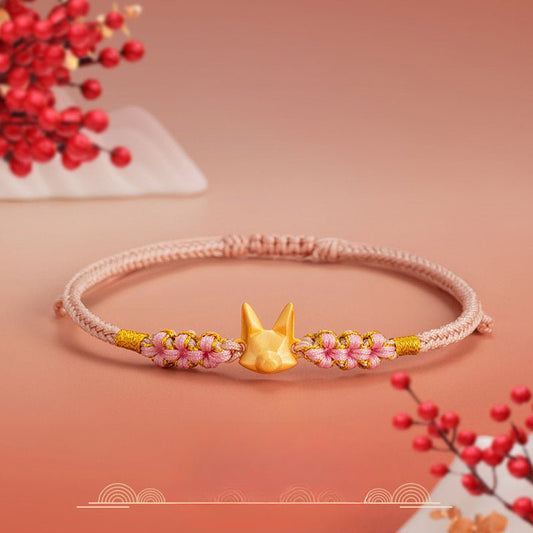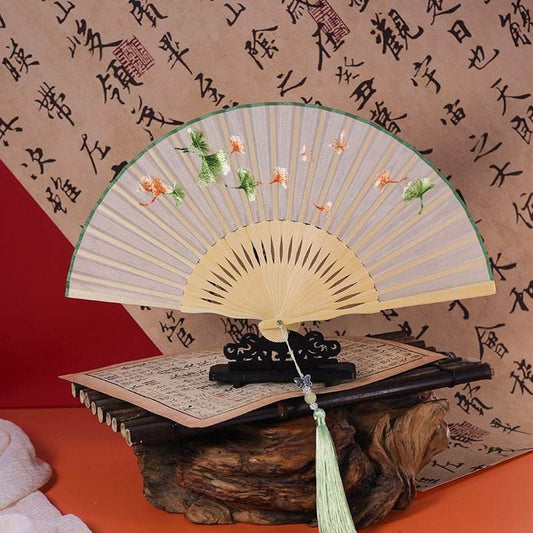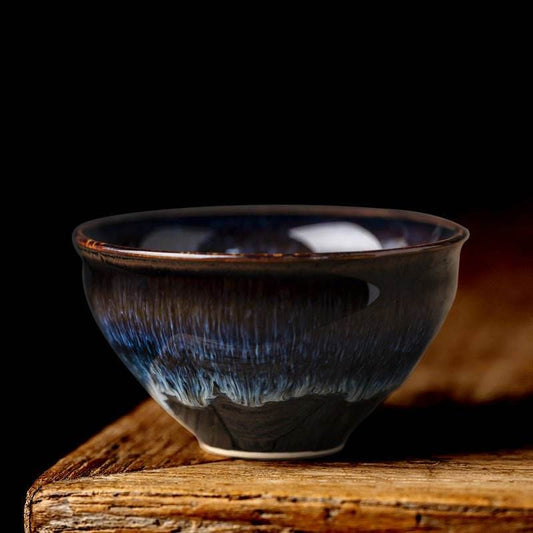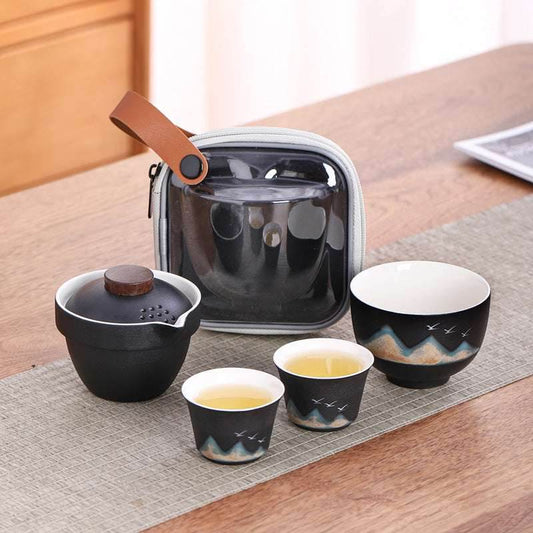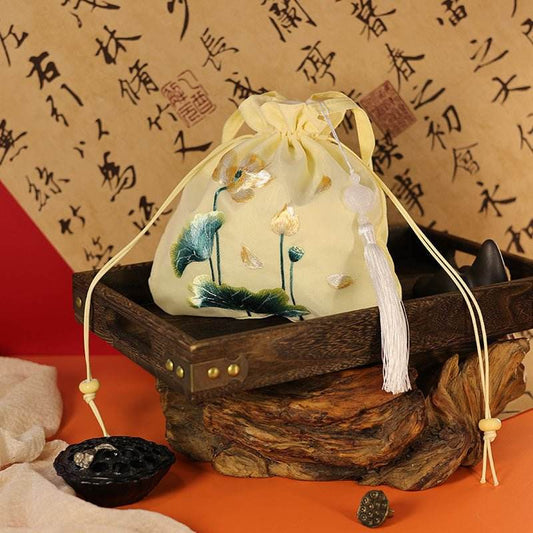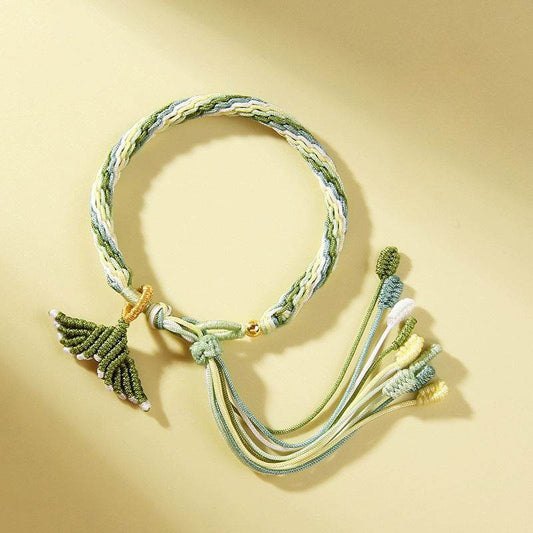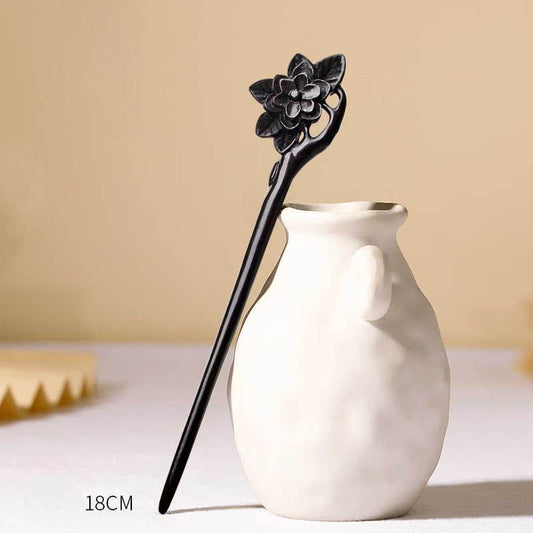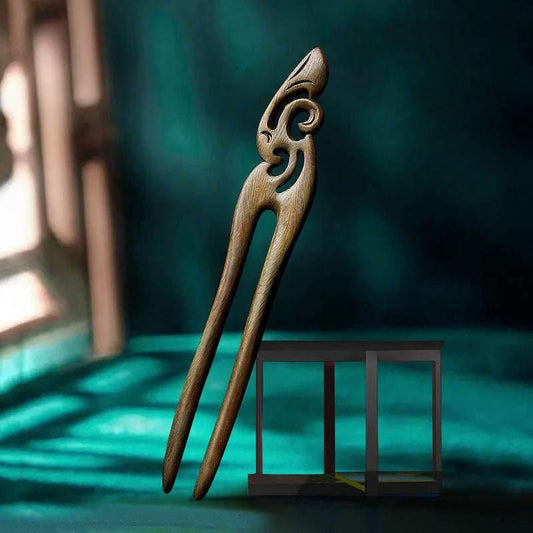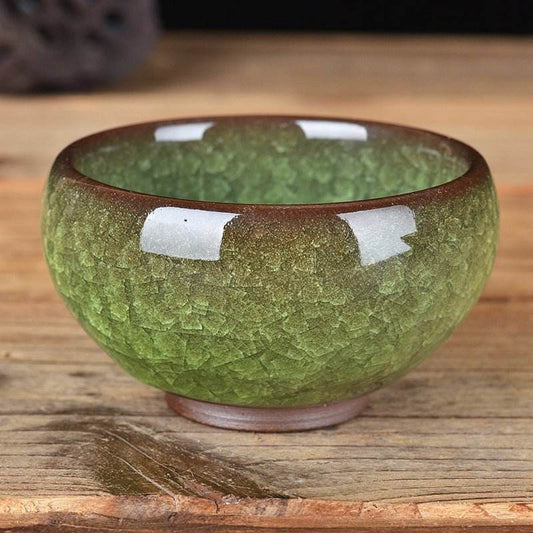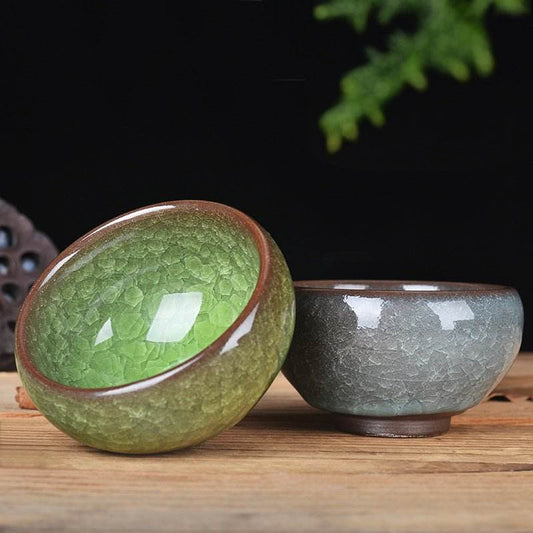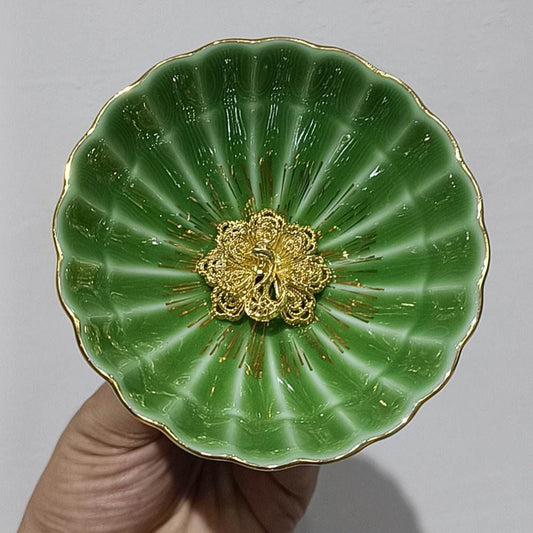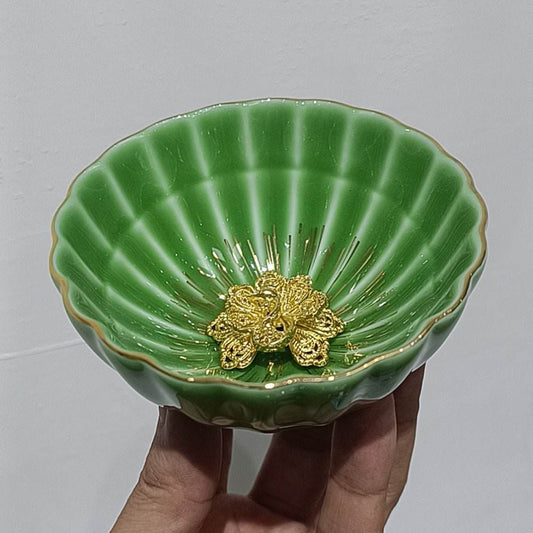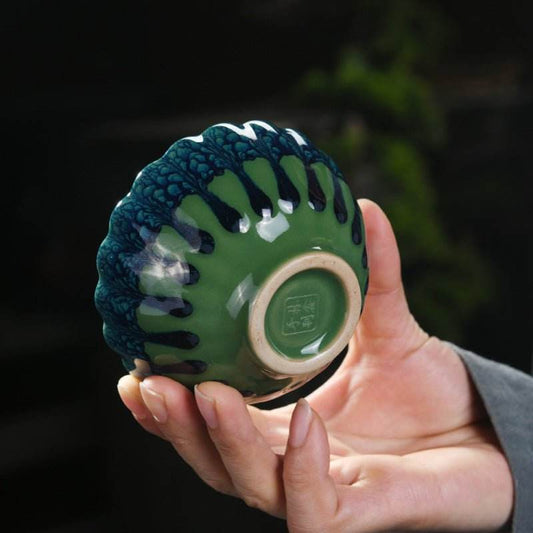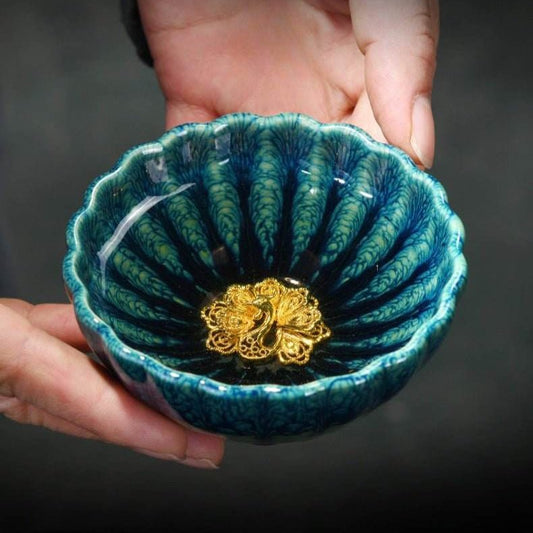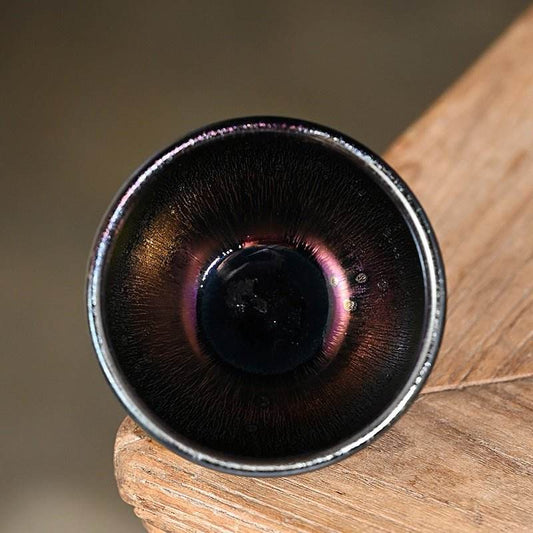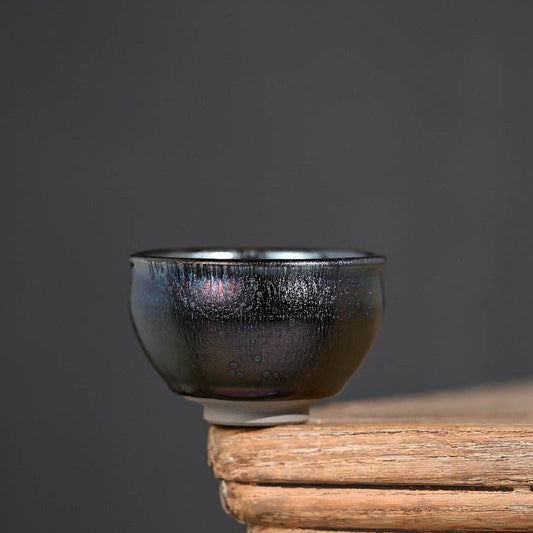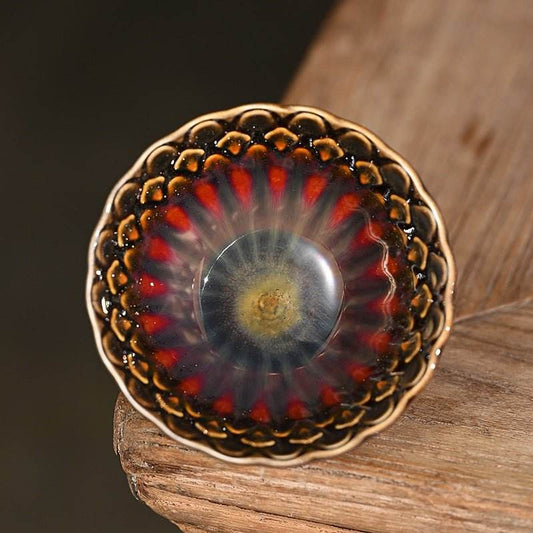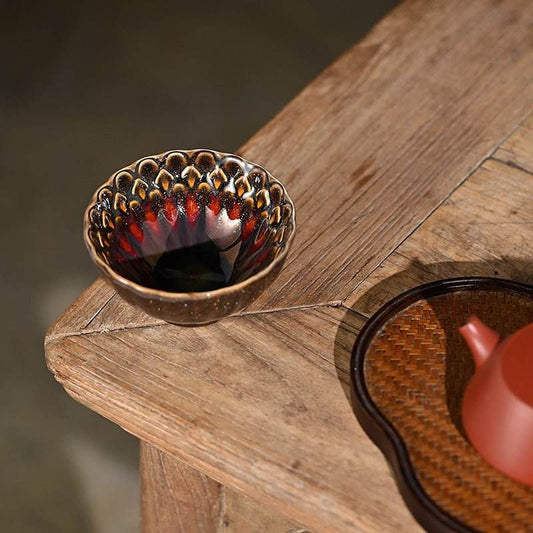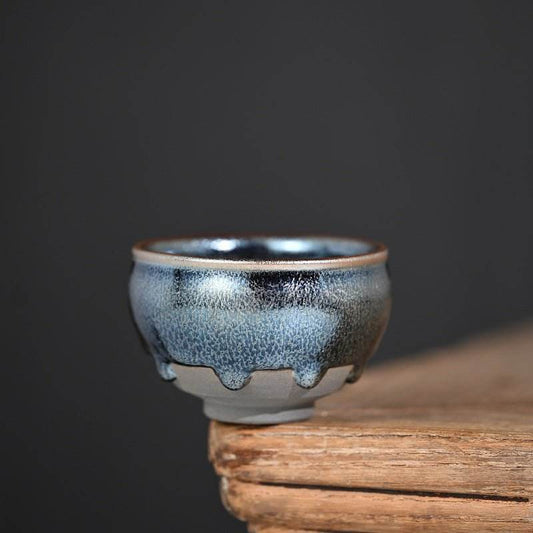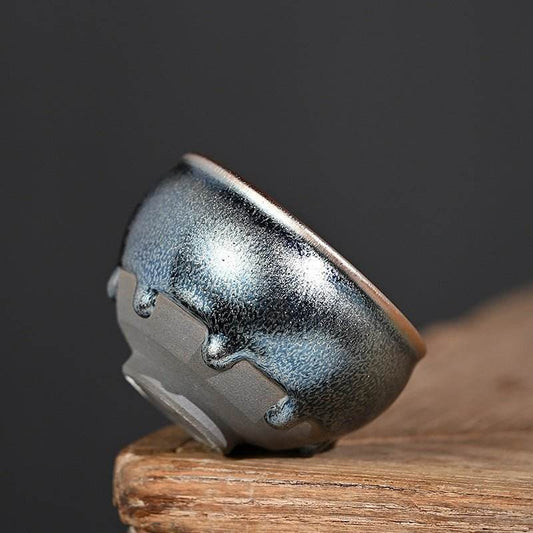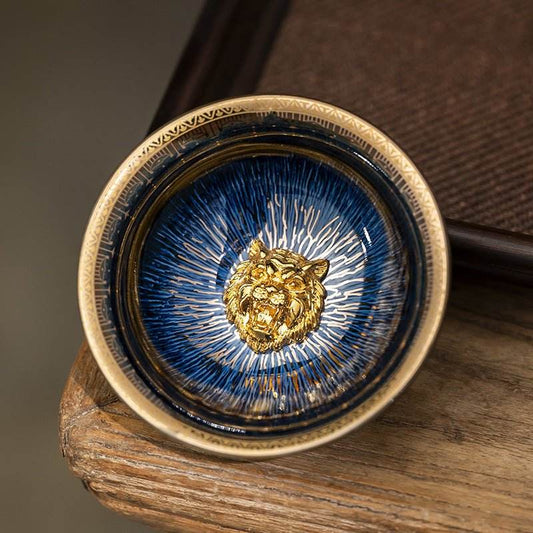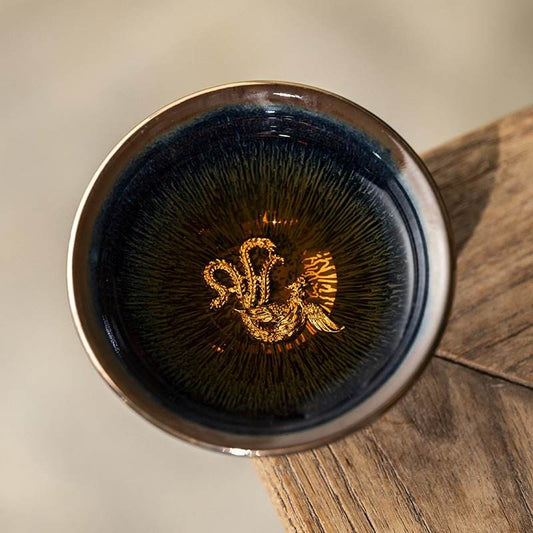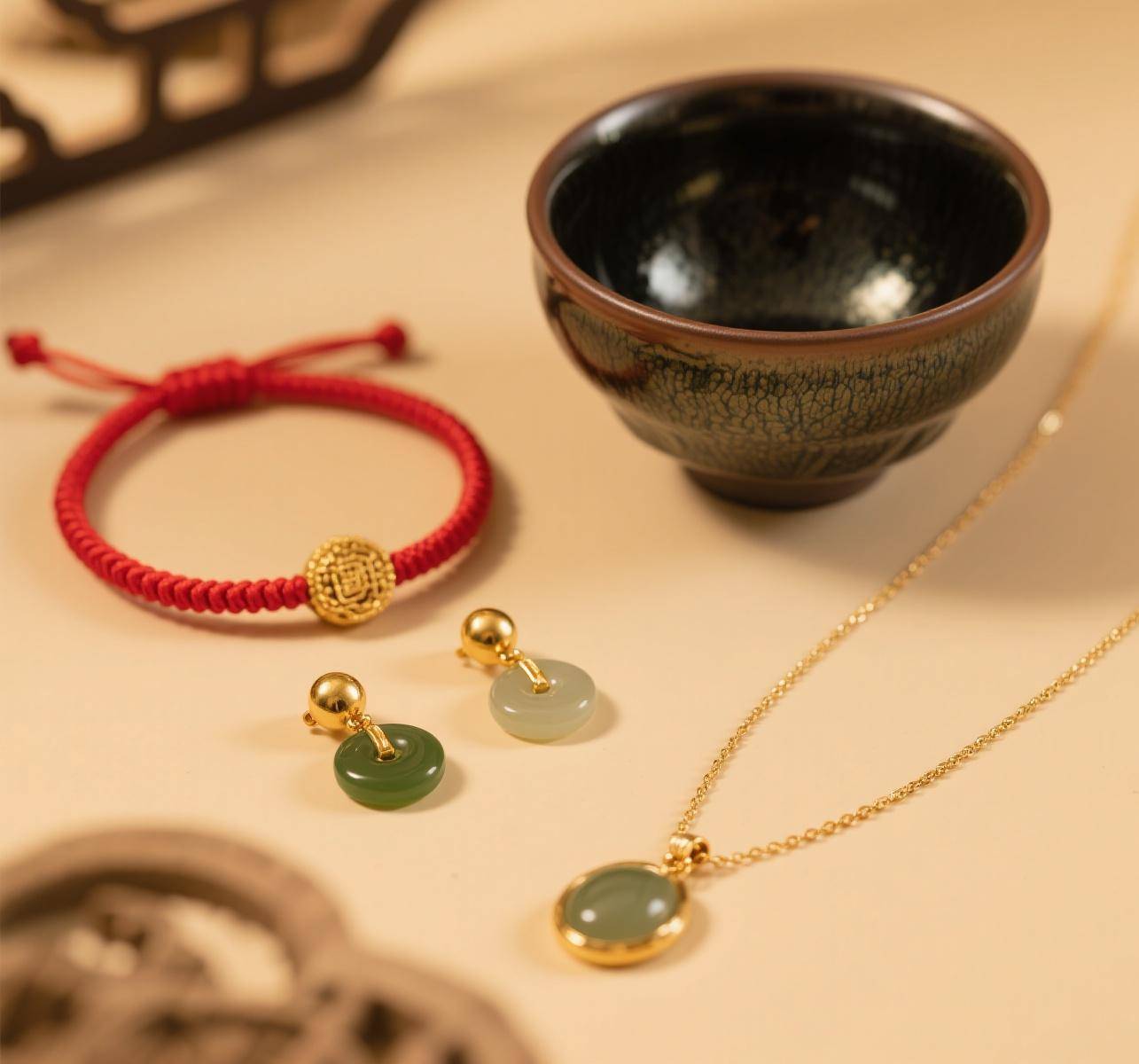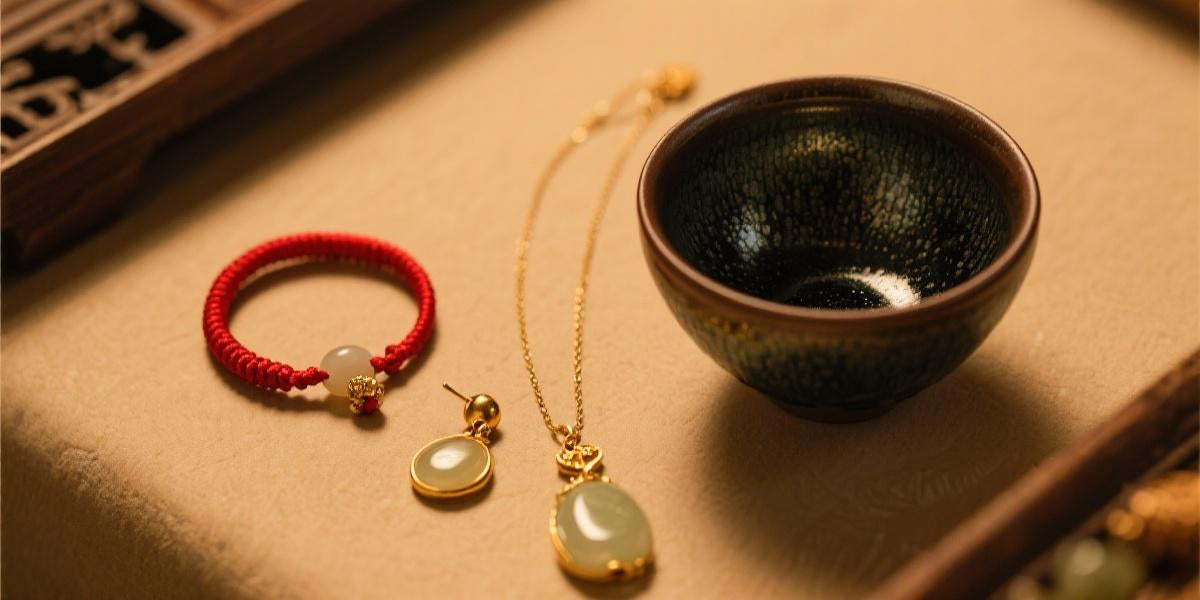-
Jianzhan Tea Cups – Home Ice Crackle Glaze, Stress Relief for Daily Sipping & Connoisseur Pride
Regular price $25.88save: 50% Sale price $25.88 Regular priceUnit price / per$51.99🍵 Jianzhan Tea Cups: Home Ice Crackle Glaze for Daily Stress - Free Sipping
Explore the charm of Jianzhan Tea Cups—featuring classic ice crackle glaze, inheriting Jianzhan craftsmanship. 🌟 The unique glaze texture blooms like ice cracks, letting you release stress with every sip in daily use.
💎 Why Love Jianzhan Tea Cups
- ✨ Ice crackle glaze craft, each cup’s texture is unique, showing natural aesthetics
- ⚡ High - quality body material, good heat retention for better tea taste
- 🍃 Balances daily use and collection value, showing connoisseur taste
✨ Key Advantages
Unlike ordinary cups, Jianzhan Tea Cups offer triple benefits:
- 🎨 Traditional craft meets modern aesthetics, combining visual and practical appeal
- 🧪 Tested lead - free material, safe for daily use
- 🎁 Simple design fits various scenarios, ideal for self - use or gifting
📌 Perfect For These Scenarios
- 🕒 Daily home use for relaxation
- 🎎 Small gatherings with friends to share tea fun
- 🏠 Home display to show artistic taste
⚙️ Technical Specifications
- 🌱 Material: Natural mineral soil + ice crackle glaze
- 🔥 Process: Traditional Jianzhan firing technique
- 📏 Size: [Fill if known, e.g., 9cm (D) × 5cm (H)]
- 🫖 Capacity: [Fill if known, e.g., 130ml]
⚠️ Care Essentials
- 💦 Rinse with warm water before first use to remove impurities
- 🧼 Clean with a soft cloth—avoid scratching the glaze
- 🗃️ Store without stacking to prevent collision damage
Sale -
Peacock Tea Cups - Handmade Kintsugi Jade Translucent, Tea Ceremony Stress Relief & Artistic Pride
Regular price $19.88save: 52% Sale price $19.88 Regular priceUnit price / per$41.99🍵 peacock tea cups: Handmade Jade - Translucent Peacock Art
Experience the charm of peacock tea cups—inspired by peacocks, crafted into jade - translucent masterpieces. 🌟 The emerald glaze with delicate golden decor, hand - made to give each cup unique life, turning tea sipping into art.
💎 Why Tea Enthusiasts Choose peacock tea cups
- ✨ Jade - translucent glaze for an immersive tea - viewing experience
- ⚡ Hand - crafted with exquisite golden details for premium quality
- 🍃 Unique peacock design, perfect for both tea rituals and space decor
✨ Key Advantages
Unlike ordinary cups, peacock tea cups offer triple benefits:
- 🎨 Each cup is uniquely hand - made with exclusive glaze and decor
- 🧪 High - quality ceramic, lead - free and durable golden decor
- 🎁 Ideal for tea ceremonies, art collection, and premium gifting
📌 Perfect For These Scenarios
- 🕒 Personal zen tea - enjoying moments
- 🎎 Traditional tea ceremonies and gatherings
- 🏯 Decoration for Chinese - style tea rooms and homes
⚙️ Technical Specifications
- 🌱 Material: Ceramic + hand - applied golden decor
- 🔥 Process: Handmade firing + glaze treatment + gold inlay
- 📏 Size: [Fill actual size if known, e.g., 9cm (D)]
- 🫖 Capacity: [Fill actual capacity if known, e.g., 120ml]
⚠️ Care Essentials
- 💦 Wipe gently with a soft cloth—avoid scratching golden parts
- 🧼 Avoid strong acid/alkali cleaners, rinse gently with warm water
- 🗃️ Store safely without collision—preferably in a gift box
Sale -
Peacock Tea Cups Couple Set – Handmade Gold-Inlaid, Tea Ceremony Stress Relief & Love Prestige
Regular price $25.88save: 50% Sale price $25.88 Regular priceUnit price / per$51.99🍵 peacock tea cups: Kiln - change Gold - inlaid & Peacock Aesthetic
Explore the charm of peacock tea cups—inspired by peacock tail feathers, combining kiln - change and gold - inlay techniques. 🌟 With “one color in kiln, thousands out of kiln”, each cup has unique glaze, paired with 3D gold inlay—ideal for tea art and ceremonies.
💎 Why Love peacock tea cups
- ✨ Kiln - change craft creates unique glaze textures like peacock eyes
- ⚡ Gold - inlaid design enhances luxury, perfect for tea gatherings or couples
- 🍃 Ceramic material with gift box—elegant for personal use or gifting
✨ Key Advantages
Unlike ordinary cups, peacock tea cups offer triple benefits:
- 🎨 Each cup set has unique kiln - transformed glaze, artistic & practical
- 🧪 Lead - free ceramic, durable gold inlay that won’t fade
- 🎁 Exquisite gift box, two colors available to suit different tastes
📌 Perfect For These Scenarios
- 🕒 Double - person tea sessions, couples’ zen moments
- 🎎 Traditional tea ceremonies, high - end gifting
- 🏯 Decoration for Chinese - style tea rooms and homes
⚙️ Technical Specifications
- 🌱 Material: Ceramic + K - gold
- 🔥 Process: Kiln - change firing + gold - inlaid craft
- 📏 Size: 9cm (D) × 4.8cm (H)
- 🫖 Capacity: 120ml per cup
- 🎁 Packaging: Gift box, two colors (blue/green) optional
⚠️ Care Essentials
- 💦 Wipe with soft cloth before first use—avoid scratching gold parts
- 🧼 Clean with warm water gently—don’t soak too long
- 🗃️ Store without collision, preferably in the gift box
Sale -
Tenmoku Tea Cup – 35% Heat Retention, Stress Relief & Ceremonial Prestige
Regular price $28.88save: 45% Sale price $28.88 Regular priceUnit price / per$52.99🍵 Tenmoku Tea Cup: Millennium Jian Zhan Craft & Colorful Oil - drop Art
Explore the charm of Tenmoku Tea Cup—blending 1000 - year Jian Zhan techniques with colorful oil - drop glaze art. 🌟 Made from Jianyang clay, fired over 1300℃, forming unique oil - drop patterns. Designed for tea lovers, with 35% heat retention, adding zen to every sip.
💎 Why Tea Enthusiasts Choose Tenmoku Tea Cup
- ✨ High - temperature firing creates “glaze tears” and plump oil drops
- ⚡ Body with tiny pores for 35% better heat retention
- 🍃 Inherits Tang - Song Jian Zhan craft, shining under sunlight
✨ Key Advantages
Unlike ordinary cups, Tenmoku Tea Cup offers triple benefits:
- 🎨 Each cup’s glaze is uniquely kiln - transformed
- 🧪 Natural clay, lead - free for safe use
- 🎁 Comes with elegant packaging, ideal for collection or gifting
📌 Perfect For These Scenarios
- 🕒 Personal zen moments with oolong or white tea
- 🎎 Traditional gongfu tea ceremonies and gatherings
- 🎁 Premium gifting for festivals, birthdays
- 🏯 Decoration for Chinese - style tea rooms and zen spaces
⚙️ Technical Specifications
- 🌱 Material: Jianyang clay + natural glaze stone
- 🔥 Process: Fired over 1300℃, kiln - transformed naturally
- 📏 Size: 9cm (D) × 6cm (H)
- 🫖 Capacity: Approx 145ml
⚠️ Care Essentials
- 💦 Rinse with warm water before first use
- 🧼 Clean with soft cloth—avoid scratching the glaze
- 🗃️ Store dry, display individually
Sale -
peacock tea cups - Calming Zen Tea Ceremony Essential for Stress Relief & Mastery
Regular price $28.88save: 45% Sale price $28.88 Regular priceUnit price / per$52.99🍵 peacock tea cups: Song Dynasty Kiln Art & Peacock Aesthetics for Tea Ritual
Explore the charm of peacock tea cups—blending Song Dynasty kiln techniques with peacock - inspired design. 🌟 Made from rare clay (8% iron content) fired at 1300℃, they show star - spot glazes like peacock feathers. Designed for tea lovers, with 30% heat retention, letting you enjoy every sip in calming zen moments.
💎 Why tea lovers choose peacock tea cups:
- ✨ Unique star - spot glaze from oxidation - reduction firing
- ⚡ Peacock - feather - edge design for elegant grip
- 🍃 Ancient clay softens water for smoother tea
✨ Key Advantages of peacock tea cups
Unlike ordinary cups, peacock tea cups offer triple advantages:
- 🎨 Each cup’s star - spot pattern is uniquely hand - crafted
- 🧪 Tested lead - free materials for safe use
- 🎁 Ideal as artistic collectibles or premium gifts
📌 Perfect For These Scenarios
- 🕒 Morning zen tea meditation
- 🎎 Traditional gongfu tea ceremonies
- 🎄 Luxury gifts for tea - loving friends
- 🏯 Decor for Chinese - style tea rooms
⚙️ Technical Specifications
- 🌱 Material: Song - era kiln - site rare clay + red ore glaze
- 🔥 Firing: 1300℃ oxidation - reduction process
- 📏 Size: 9.6cm (D) × 5.2cm (H)
- 🫖 Capacity: 140ml (±2% variance)
⚠️ Care Essentials
- 💦 Pre - rinse with warm water before first use
- 🧼 Clean with soft cloth—avoid abrasive tools
- 🗃️ Store in dry, breathable space—avoid stacking
Sold out -
🔥Proven 50% Aroma Enhancement - Jian Zhan Tea Cups for Anxiety-Free Tasting & Proud Collector’s Display
Regular price $28.88save: 45% Sale price $28.88 Regular priceUnit price / per$52.99🍵 Jian Zhan Tea Cups: Enhance Your Tea Ritual with Ancient Artistry
Discover the magic of Jian Zhan Tea Cups—where 800 - year - old Chinese craftsmanship meets modern tea culture. 🌟 These cups, made from Jianyang mineral clay and fired at 1300℃, feature mesmerizing yaobian glaze patterns. Perfect for oolong and pu - erh lovers, Jian Zhan Tea Cups naturally enhance tea aroma by 40% through their micro - crystalline structure. Every sip becomes a journey through Song Dynasty tea traditions!
💎 Why tea masters worldwide choose Jian Zhan Tea Cups:
- ✨ Unique glaze patterns formed during reduction firing
- ⚡ Ergonomic design fits perfectly in palm (8.8cm diameter)
- 🍃 Natural clay softens water pH to 6.3 - 6.5 range
✨ Key Benefits of Jian Zhan Tea Cups
Unlike ordinary tea cups, Jian Zhan Tea Cups offer triple advantages:
- 🎨 Each cup is a unique art piece with self - generated glaze patterns
- 🧪 Lab - tested lead - free materials (SGS Report #TC2024 - 15)
- 🎁 Comes with ICOM - certified collector's documentation
📌 Perfect For These Scenarios
- 🕒 Morning meditation with rock tea
- 🎎 Traditional gongfu tea ceremonies
- 🎄 Luxury Christmas gifts for tea enthusiasts
⚙️ Technical Specifications
- 🌱 Material: Jianyang mineral clay + tenmoku glaze
- 🔥 Firing: 1300℃ reduction flame (72hr process)
- 📏 Size: 8.8cm diameter × 6cm height
- 🫖 Capacity: 150ml (±2% variance)
⚠️ Care Essentials
- 💦 Pre - rinse with 60℃ water before first use
- 🧼 Clean with bamboo fiber cloth only
- 🗃️ Store vertically in breathable cotton pouch
Sale -
Chinese Tea Cups Handmade Yaobian Jian Zhan Ceramic Artisan
Regular price $28.88save: 45% Sale price $28.88 Regular priceUnit price / per$52.99Chinese Tea Cups: Yaobian Glaze Handcrafted Elegance
✨ Why Choose This Jian Zhan Cup?
This tea cup combines celestial beauty with practicality. The yaobian glaze shimmers with cosmic patterns, while natural clay minerals gently enhance tea's richness, creating a smoother drinking experience compared to regular ceramics.
🌿 Nature's Tea Enhancement
Hand-carved peacock relief offers ergonomic grip, preventing slips during pouring. Reinforced with traditional kintsugi, it withstands daily use while maintaining artistic integrity.
🎁 Culturally Significant Gift
Each piece reflects 100+ hours of artisan craftsmanship. Ideal for tea connoisseurs or as decorative art, it embodies Chinese cultural heritage in functional form.
Usage Scenarios
Daily tea rituals|Cultural gatherings|Asian home decor|Premium gifting|Tea master's toolkit
Product Specifications
Material: Natural yaobian clay
Craft: Handmade kintsugi/underglaze crystallization
Capacity: 100ml (standard tea session)
Diameter: 8.5cm (ergonomic design)Care Instructions
• Rinse with warm water before first use
• Clean glaze with microfiber cloth
• Store separately to prevent chippingSale -
Jianyang Jianzhan Partridge-spot Master Cup Perfect for Tea Aroma Enjoyment
Regular price $26.88save: 49% Sale price $26.88 Regular priceUnit price / per$52.99Product Description
Jianyang Jianzhan Partridge-spot Master Cup: Exquisite Tea-tasting Vessel
This product belongs to the tea set category. Crafted with local raw ore and iron-based body in Jianyang, it features unique partridge-spot textures like partridge feathers, natural and varied. The cup has eye-shaped markings, adding mysterious beauty. As a master cup, its superb craftsmanship and good heat preservation enhance tea aroma, a perfect choice for tea-tasting lovers.
Usage Scenarios
Personal Tea Tasting
Suitable for individuals to enjoy tea leisurely, experiencing Jianzhan’s charm and tea aroma blend.
Tea Enthusiasts Gathering
When sharing tea with friends, this Jianzhan master cup shows taste and better presents tea’s charm.
Product Parameters
Product Name
Jianyang Jianzhan Partridge-spot Master Cup with Eye-shaped Markings
Material
Raw Ore Materials, Iron-based Body
Specification
Size details in product info (handheld tea-tasting size).
Craftsmanship
Traditional firing for unique partridge-spot textures.
Precautions
Maintenance Notes
• Avoid collisions—ceramic and fragile;
• Prevent sudden temperature changes to avoid cracks;
• Clean and dry after use to keep appearance.Sale
Collection: Chinese Tea Cups
Chinese tea cups are not just functional objects, but hold deep cultural and historical significance. From the simple clay cups of ancient times to the intricate porcelain and clay masterpieces of today, these tea cups are symbols of a rich tradition that spans millennia. Their design, symbolism, and craftsmanship tell the story of China's long relationship with tea and the spiritual journey that this beverage represents.
In this article, we’ll explore the fascinating history of Chinese tea cups, the types of cups used in tea ceremonies, and the meanings behind the designs that have been passed down through generations.
The History of Chinese Tea Cups 🏯
Origins of Tea Drinking in China 🍃
Tea is an integral part of Chinese culture, and its history dates back over 5,000 years. According to legend, Emperor Shen Nong discovered tea in 2737 BCE when tea leaves blew into a pot of boiling water he was preparing. While this story may be apocryphal, it symbolizes tea’s deep connection with Chinese history and culture. Initially, tea was used as a medicinal herb, believed to have health benefits, before becoming a beloved beverage.
Over time, tea became more than just a health drink. By the Tang Dynasty (618-907 AD), it had become a popular drink, consumed by people from all walks of life, from peasants to royalty. Tea drinking became a social event, and tea cups began to evolve from simple containers to artistic and symbolic vessels used in elaborate tea ceremonies.
Evolution of Tea Cups 🍵🖋️
The evolution of Chinese tea cups is a reflection of the changing times, culture, and values of the Chinese people. Early tea cups were rudimentary and practical, but over the centuries, they became symbols of artistry and refinement.
-
Tang Dynasty (618-907 AD): Tea cups during this time were often simple, made from clay or porcelain. They were primarily functional and served as basic vessels for brewing and drinking tea. However, the Tang period also marks the early rise of tea drinking as a social activity.
-
Song Dynasty (960-1279 AD): The Song Dynasty saw the rise of porcelain tea cups, known for their refined designs and elegance. Tea drinking became associated with leisure, and porcelain cups began to be decorated with intricate patterns of flowers, birds, and symbolic designs. During this period, tea was elevated to a high art form, and the tea cup became a symbol of intellectual refinement and social status.
-
Ming Dynasty (1368-1644 AD): The Ming Dynasty is credited with introducing Yixing clay tea cups, which are still highly prized today. Known for their natural beauty and ability to enhance the taste of tea, these cups were made from clay that was believed to interact with tea in a way that elevated its flavor profile. The cups from this era were often simple and elegant, emphasizing the beauty of natural materials.
-
Qing Dynasty (1644-1912 AD): The Qing Dynasty further refined tea cup designs, creating intricate and decorative cups made from porcelain. The Qing period saw the development of highly ornate tea cups, often hand-painted with scenes of nature, historical events, and even calligraphy. The designs were elaborate, reflecting the wealth and social status of the owner.
Tea and the Chinese Dynasties 🌿👑
Throughout the various dynasties, tea drinking became an essential part of Chinese culture, influencing social life, art, and politics. Each dynasty introduced new customs, ceremonies, and types of tea cups that would shape tea culture for generations.
-
Ming Dynasty: The Ming Dynasty marks a significant period in tea culture, where tea cups, particularly Yixing clay tea cups, became integral to tea ceremonies. These cups were designed with simplicity and functionality in mind, and they quickly became highly prized by tea connoisseurs. The Yixing clay is known for its unique porous nature, which helps to retain the tea’s natural flavors, making it a favorite for brewing oolong and pu-erh teas.
-
Qing Dynasty: The Qing Dynasty is known for its more luxurious and decorative tea cups, which were used during formal tea ceremonies. These cups were often elaborately decorated with symbols of good fortune, prosperity, and longevity. The Qing period is also known for the development of porcelain tea cups that became globally recognized for their fine craftsmanship and beauty.
The Role of Tea Cups in Chinese Tea Ceremonies 🍃🙏
Tea drinking in China is much more than a casual experience—it’s an intricate ceremony that emphasizes respect, mindfulness, and harmony. Tea cups play a central role in these ceremonies, each serving a specific purpose in the ritual.
-
Gong Fu Cha (功夫茶): One of the most well-known Chinese tea ceremonies is Gong Fu Cha, which involves using small, elegant tea cups to carefully brew and sip tea. The ceremony emphasizes the art of tea preparation and the enjoyment of tea's aroma, flavor, and visual appeal. Tea cups used in this ceremony are typically small and refined, allowing for multiple infusions to extract the full flavor of the tea.
-
Respect and Generosity: In Chinese culture, offering tea to guests is a gesture of respect and generosity. The tea cups used in these ceremonies are often chosen with great care to reflect the occasion and the host's reverence for the guest. Whether the ceremony is grand or simple, the tea cups serve as a symbol of hospitality and cultural etiquette.
Types of Chinese Tea Cups 🍵
Chinese tea cups come in a wide variety of materials, each chosen for its unique properties and symbolism. Let’s take a look at the different types of Chinese tea cups and their significance.
Porcelain Tea Cups 🏺💮
Porcelain has long been the material of choice for Chinese tea cups. The material is known for its delicate texture, smooth finish, and ability to retain heat, making it ideal for brewing and drinking tea. Porcelain cups are often decorated with intricate designs, many of which carry deep cultural significance.
-
Symbolism: Porcelain tea cups are often adorned with designs such as dragons, phoenixes, and lotus flowers, each representing good fortune, spiritual enlightenment, and purity. These symbols have been used for centuries to impart positive energy to the tea-drinking experience.
-
Uses: Porcelain tea cups are versatile and suitable for a variety of teas, including green tea, oolong tea, and black tea. The smooth surface of porcelain enhances the flavor and aroma of the tea, making it a popular choice for both casual and formal tea ceremonies.
Yixing Clay Tea Cups 🏺🖤
Yixing clay is a unique type of clay that originates from the Yixing region in China. Known for its porous nature, Yixing clay absorbs the flavors of the tea over time, which enhances the taste with each use. Yixing tea cups are revered for their natural beauty and their ability to bring out the best in tea.
-
Symbolism: Yixing clay tea cups represent simplicity, harmony, and the natural world. The clay’s earthy tones connect tea drinkers to the earth and symbolize the balance between man and nature.
-
Uses: These tea cups are particularly popular for brewing oolong tea, pu-erh tea, and black tea. The porous nature of Yixing clay allows the tea to breathe and develop a richer flavor profile over time, making it ideal for tea connoisseurs who appreciate the subtleties of tea.
Glass Tea Cups 🍶🌿
Glass tea cups have gained popularity in recent years, especially among tea drinkers who enjoy watching the brewing process. The transparent nature of glass allows the drinker to appreciate the color and clarity of the tea, adding a visual element to the experience.
-
Symbolism: While glass tea cups do not carry the same deep cultural symbolism as porcelain or Yixing clay, they are associated with transparency, clarity, and purity—qualities that are essential for enjoying a fine cup of tea.
-
Uses: Glass tea cups are perfect for teas that have a visual appeal, such as flowering teas, where the tea leaves bloom into a beautiful display. They are also ideal for delicate teas like white tea and green tea, where clarity is important for appreciating the nuances of the tea.
Gaiwan (Lidded Cups) 🍃🍶
A Gaiwan is a traditional Chinese tea cup consisting of three parts: a bowl, a lid, and a saucer. The Gaiwan is used both for brewing and drinking tea, and it plays an essential role in the Gong Fu Cha ceremony.
-
Symbolism: The Gaiwan represents balance and harmony, bringing together the elements of tea, water, and air. Its simple, elegant design reflects the Chinese philosophy of Yin and Yang, where opposing forces are balanced in perfect harmony.
-
Uses: The Gaiwan is used for brewing a variety of teas, including green tea, oolong tea, and white tea. Its lid helps regulate the temperature while steeping, ensuring that the tea maintains its delicate flavors and aromas.
Lacquered or Hand-painted Tea Cups 🎨🍃
Lacquered or hand-painted tea cups are often used as decorative pieces, showcasing Chinese artistry and craftsmanship. These cups are adorned with intricate designs, ranging from nature scenes to calligraphy, and are often passed down through generations.
-
Symbolism: The artistry of lacquered and hand-painted tea cups reflects the importance of beauty and craftsmanship in Chinese culture. These cups often feature symbols of good luck, prosperity, and longevity.
-
Uses: While these cups are often reserved for special occasions or ceremonial purposes, they can also be enjoyed for daily tea drinking, particularly when one wishes to elevate the experience.
Jianzhan Tea Cups 🍂✨
Jianzhan tea cups, made from clay sourced from the Jian region of China, are famous for their distinct glaze patterns, particularly the hare’s fur glaze. These cups were first created during the Song Dynasty and are revered for their rarity and beauty.
-
Symbolism: The unique glaze patterns of Jianzhan tea cups symbolize the natural world and the passage of time. The glaze is created through a specific firing technique, which produces a rich, textured surface that enhances the tea-drinking experience.
-
Uses: Jianzhan cups are ideal for green tea and oolong tea, as the rich glaze and texture complement the flavors of these delicate teas. The craftsmanship and rarity of Jianzhan tea cups make them prized possessions for tea collectors.
Tenmoku Tea Cups 🍂🎋
Tenmoku tea cups, while developed in Japan, have deep roots in Chinese tea culture, particularly influenced by the Jianzhan style. The Tenmoku glaze is known for its dark, rich colors, often with a speckled pattern resembling a starry sky.
-
Symbolism: The Tenmoku glaze symbolizes depth and mystery, with its dark tones reflecting the hidden beauty of nature. It also signifies purity and quiet contemplation.
-
Uses: Tenmoku tea cups are best used for oolong tea, where the complex flavors can be fully appreciated. They are also perfect for showcasing the art of tea brewing and the serene atmosphere of a traditional tea ceremony.
Symbolism of Chinese Tea Cups 🐉💫
Tea cups in Chinese culture are not just vessels for drinking; they are imbued with deep meanings, representing aspects of life, nature, and the universe. Each material, design, and pattern has its own symbolic significance, contributing to the overall tea-drinking experience.
Symbolism of Materials 🏺
Different materials used to create tea cups in China carry significant symbolism that reflects the philosophy and values of Chinese culture. Whether it’s porcelain, Yixing clay, glass, or lacquered wood, the material plays a key role in conveying deeper meanings:
-
Porcelain: Representing purity and elegance, porcelain tea cups are highly revered for their smooth surface and aesthetic beauty. These cups symbolize refinement, serenity, and the spiritual connection between the tea drinker and the natural world.
-
Yixing Clay: Known for its earthy tones and ability to enhance the flavors of tea, Yixing clay represents harmony with nature. The porous nature of Yixing clay allows the cup to "absorb" the tea’s essence, making each brew richer over time, symbolizing growth and connection to the earth.
-
Glass: Although glass does not carry the same deep historical symbolism as porcelain or Yixing clay, it represents clarity and transparency. It’s perfect for appreciating the color and clarity of the tea, reflecting the value of purity and openness in Chinese culture.
Common Designs and Their Meanings 🌸🐉
The designs on Chinese tea cups are not just decorative; they are filled with symbolic meanings that align with Chinese philosophy and spirituality. Here are some of the most common motifs:
-
Dragons and Phoenixes 🐉🦅: These mythical creatures symbolize good fortune, strength, and prosperity. The dragon is associated with masculinity, power, and good luck, while the phoenix represents rebirth, beauty, and grace. These symbols are often featured on porcelain tea cups to bring positive energy to the tea-drinking experience.
-
Lotus Flowers 🌸: The lotus is a powerful symbol of purity and spiritual enlightenment. It grows from the mud yet blooms beautifully above the water’s surface, symbolizing the ability to rise above adversity and remain pure in spirit. Tea cups adorned with lotus designs are a reminder of inner peace and transcendence.
-
Peach Blossoms 🍑: In Chinese culture, the peach represents longevity, immortality, and good health. It’s often depicted in tea cups as a symbol of vitality and a long, prosperous life. This design is commonly found on cups used during significant events like birthdays and celebrations.
-
Bamboo 🎋: Bamboo is a symbol of resilience, strength, and flexibility. Its ability to bend without breaking makes it a powerful metaphor for the ability to adapt to challenges in life. Tea cups featuring bamboo designs are reminders to stay strong and flexible during difficult times.
-
Crane Birds 🦢: Cranes are long associated with longevity and immortality in Chinese culture. These graceful birds are often depicted in tea cups as symbols of enduring strength and wisdom. They are especially popular in tea cups used for spiritual or meditative purposes.
Balance and Harmony in Tea Cups ⚖️🌿
In traditional Chinese philosophy, balance and harmony are essential elements in all aspects of life, from personal relationships to environmental practices. Yin and Yang, the ancient Chinese concept of opposing forces that balance one another, is reflected in the design of tea cups.
-
Yin and Yang: Tea cups are designed to maintain balance between opposing forces, such as light and dark, smooth and rough, or solid and fluid. In this way, the design of a tea cup is often meant to evoke balance between the energy of the tea, the person drinking it, and the surrounding environment.
-
Circular Designs: Circular shapes, like those of most tea cups, are also symbolic of the universe and wholeness. This shape represents an eternal cycle, free from beginning or end, reflecting the continuity of life and the infinite flow of energy.
Modern Significance of Chinese Tea Cups 🌏
While Chinese tea cups have deep traditional roots, their significance has continued to evolve. Today, they are used not only in formal tea ceremonies but also as decorative items, collectibles, and even as a way to connect to the past.
Tea Culture Around the World 🌍
Chinese tea cups have become an iconic part of global tea culture. Their designs and craftsmanship are admired by tea drinkers worldwide, and they have influenced tea-drinking rituals beyond China. In places like Japan, Taiwan, and even Western countries, Chinese tea cups are valued for their beauty, function, and the cultural history they carry.
-
Japanese Influence: The Japanese tea culture has been greatly influenced by Chinese tea practices, especially the Gong Fu Cha tea ceremony. Tenmoku cups, originally inspired by Chinese tea cups, are now a staple in Japanese tea ceremonies, showcasing how Chinese tea cups continue to shape global tea rituals.
-
International Tea Collectors: Chinese tea cups, particularly antique porcelain or Yixing clay cups, are highly sought after by collectors. These cups are not only valued for their artistic beauty but also for the cultural significance they represent.
Tea Cups as Decorative Art 🎨🍃
Over the years, Chinese tea cups have transcended their original purpose and become decorative items in their own right. Many tea enthusiasts collect these cups for their intricate designs and craftsmanship. Whether they feature hand-painted landscapes, calligraphy, or porcelain dragons, each tea cup tells a story that adds to its value.
-
Collector’s Items: Rare tea cups, especially those from the Qing Dynasty or ancient Jianzhan cups, are highly prized by collectors. These cups are often seen as art pieces that preserve Chinese cultural heritage.
-
Home Décor: Tea cups are also used as decorative objects in homes and tea rooms. Displayed on shelves or tables, they add an elegant touch to any space, serving as a reminder of the artistry and cultural history behind each vessel.
Tea Cups in Contemporary Life 🏡💫
In modern times, Chinese tea cups continue to play an important role in the daily lives of many people. While they may no longer be used in traditional tea ceremonies as frequently, their cultural value and aesthetic appeal remain high.
-
Mindfulness and Wellness: Many people use Chinese tea cups as part of their daily tea-drinking rituals to enhance mindfulness and well-being. The simple act of sipping tea from a beautifully crafted cup can promote a sense of calm and presence, aligning with the Chinese philosophy of balance and harmony.
-
Everyday Use: Chinese tea cups have also found their way into everyday tea drinking. Whether enjoyed with green tea, oolong tea, or black tea, these cups are a reminder of the rich history and tradition that comes with each sip.
How to Care for Your Chinese Tea Cups 🧼✨
Taking care of your Chinese tea cups is essential for maintaining their beauty and functionality. Whether you own Yixing clay, porcelain, or glass tea cups, proper care ensures they will last for years and continue to enhance your tea-drinking experience.
Cleaning and Maintenance 🧽
-
Yixing Clay Cups: Yixing tea cups are porous, meaning they absorb the tea’s flavor over time. To clean them, simply rinse with warm water. Avoid soap or detergent, as it may strip away the natural oils that build up from tea brewing. Over time, the tea cup will develop a natural patina that enhances its flavor.
-
Porcelain Cups: Porcelain tea cups should be cleaned with a mild detergent and warm water. Use a soft cloth or sponge to avoid scratching the surface. Porcelain cups should also be kept free of stains by cleaning them immediately after use, especially if they’re used for darker teas like black tea.
-
Glass Cups: Glass tea cups are the easiest to clean, requiring only a mild detergent and warm water. You can also use a little bit of vinegar to remove any tea stains. Dry them carefully with a soft cloth to prevent water spots.
Storing Your Tea Cups 🏺
-
Avoid Extreme Temperatures: Store your tea cups in a cool, dry place. Avoid exposing them to extreme temperatures or direct sunlight, which can cause cracks, fading, or damage to the glaze.
-
Use Protective Storage: For valuable or delicate tea cups, use protective cases or display cabinets to keep them safe from dust and breakage.
Avoiding Common Mistakes ❌
-
Don’t Use Harsh Chemicals: Avoid using harsh chemicals or abrasive sponges to clean your tea cups, as this can damage the surface and remove the natural oils or glazes.
-
Don’t Overstack: If you have multiple tea cups, avoid stacking them too high, as this can cause them to crack or chip. Keep each cup separate, with protective padding if necessary.
Conclusion – Embrace the Timeless Tradition of Chinese Tea Cups 🌟
Chinese tea cups are far more than simple vessels—they are a symbol of history, culture, and artistry. From their humble beginnings to their elevated status in tea ceremonies around the world, these cups continue to inspire admiration and reverence.
Whether you use them in a traditional tea ceremony, collect them as art pieces, or simply enjoy a daily cup of tea, Chinese tea cups are a beautiful reminder of the rich cultural heritage and mindfulness that tea brings to our lives. Embrace the tradition and craftsmanship behind these timeless vessels, and let them enhance your own tea-drinking experience.
